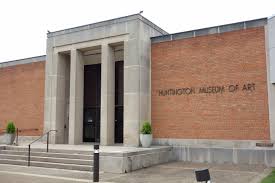Aug 12 2018 - Feb 4 2018
Huntington, WV
In the latter months of 1967, a shipment of precious cargo arrived at the Huntington Museum of Art. Included in the delivery were works by a number of the most important artists who were active in late 19th and early 20th century America, along with many stellar examples by European artists. Three watercolors by Andrew Wyeth, two oil paintings by Childe Hassam (including an example from his renowned “flag” painting series), paintings or prints by all of the members of the group known as “The Eight,” etchings by Rembrandt and Whistler, a watercolor by Winslow Homer, as well as a host of equally impressive works of art were included in the shipment. They were all given to the museum by Mrs. Ruth Woods Dayton, a resident of Lewisburg, West Virginia, and were together known as The Daywood Collection. The gift immediately elevated the status of the collection of the museum to one of national renown.
The receipt of the Dayton gift was part of an amazing sequence of events that occurred in the mid-1960s that would forever alter the destiny of the museum. The catalyst for all the good fortune was a grant of $1 million from the Doherty Foundation, a charitable organization whose leadership had ties to Huntington, for the purpose of expanding the museum’s facility. A second stroke of welcome news came when the famed architect Walter Gropius agreed to design the addition to the museum in partnership with his firm, The Architects’ Collaborative.
Mrs. Dayton and her husband, Arthur, had entered the collecting world in 1916 when they received a gift of the painting Munich Landscape, by Ross Sterling Turner, as a wedding present. That would be the beginning of a collection that would eventually number more than 200 works of art, including more than 80 paintings. They developed close relationships with some of the leading commercial galleries of the period, especially New York’s Macbeth Gallery, and acquired works by many prominent artists. A number of pieces were acquired after being seen at major exhibitions of the day, including the Carnegie International in Pittsburgh, a city that Arthur Dayton visited often in his work as an attorney. Collecting art was a passion for the Daytons, and they enjoyed doing research on the objects and writing to artists to find out more about their newest finds. Many of the works are modest in size, deliberately chosen to fit comfortably in their Charleston, West Virginia, residence.
Following Mr. Dayton’s untimely death in 1948, Ruth Dayton moved to Lewisburg and in 1951 opened a small facility called The Daywood Gallery as a memorial to her husband (the name Daywood is a combination of the couple’s family surnames, Dayton and Woods). Between 1951 and 1966, Mrs. Dayton continued to add to the collection through donations and purchases. The collection attracted the attention of a number of supporters of the Huntington Museum of Art in the early 1960s and several overtures were made to Mrs. Dayton to make a gift of her collection to the institution, but these pleas went unheeded because of the inadequate size of the existing facility. Following the Doherty Foundation grant and the promise of a sparkling new, Gropius-designed exhibition space and accompanying storage areas, Mrs. Dayton at long last agreed to give her collection to the Huntington Museum of Art. It was her wish that the collection that she and her husband had been so carefully assembled would remain in the state and be made available to the people of West Virginia, a place the Daytons had called home for their entire lives. An agreement was drawn up and signed by both parties in December, 1966, and the majority of the works were transferred to Huntington later in 1967 (a few objects remained in Mrs. Dayton’s home during the last years of her life and were later sent to the Huntington Galleries after her death in 1978).
Credit: Exhibition overview from museum website
Exhibition Venues & Dates
Aug 12 2018 - Feb 4 2018
Huntington, WV
